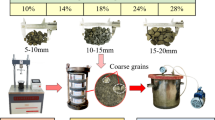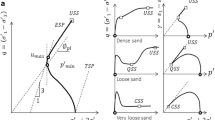Abstract
Engineering properties of sands mainly depend on the integrity of the particles, which in turn has a strong bearing on their crushing strength. Seven different Aegean sands were tested for mineralogy, particle shape, size and specific gravity and the influence of aspect ratio, particle composition, particle shape and size on the crushing strength was examined. As the Aegean sands have a small range of sphericity and roundness, crushing strength tests were also performed on five Anatolian sands. A multiple regression analysis was carried out and an equation proposed to determine the crushing strength value of the Aegean sands. The computed values were found to be in good agreement with those obtained from the experimental investigations. It is concluded that the equation is sufficiently accurate to be a useful, time- and cost-effective way of obtaining crushing strength estimations at the preliminary stage of site investigations.
Résumé
Les propriétés géotechniques de sables dépendent principalement de l’intégrité des particules qui est fortement en rapport avec leur résistance à l’écrasement. Sept sables égéens différents ont été analysés quant à la nature minéralogique des grains, la forme et la taille de particules et leur densité. Les influences de la composition des particules, de leur forme et de leur taille sur la résistance à l’écrasement ont été étudiées. Comme les sables égéens présentent des sphéricités et des émoussés peu variables, des essais d’écrasement ont aussi été réalisés sur cinq sables anatoliens. Une analyse par régression multiple a été réalisée et une équation proposée pour déterminer la résistance à l’écrasement des sables égéens. Les valeurs calculées sont apparues en bon accord avec les valeurs mesurées. On conclut que l’équation est suffisamment précise pour fournir des estimations utiles et peu coûteuses de la résistance à l’écrasement dans le contexte d’études préliminaires de site.













Similar content being viewed by others
References
Anand L, Gu C (2000) Granular materials: constitutive equations and strain localization. J Mech and Phys Solids 48:1701–1733
ASTM D 422-63 (1994) Standard test method for particle size analysis of soils, Annual Book of ASTM Standards, ASTM, West Conshohocken, PA, USA, 04.08, 10–16
ASTM D 5550 (2001) Standard test method for specific gravity of soil solids by gas pycnometer, Annual Book of ASTM Standards, ASTM, West Conshohocken, PA, USA, 04.08
Bartake PP, Singh DN (2005) Determination of crushing strength of cenospheres. J ASTM Int Published online, 2(7):9 pp
Bartake PP, Singh DN (2007) A generalized methodology for determination of crushing strength of granular materials. Geotech Geol Eng 25(2):203–213
Bishop AW (1966) The strength of soils as engineering materials. Geotechnique 16(2):91–128
Chuhan FA, Kjeldstad A, Bjorlykke K, Hoeg K (2003) Experimental compression of loose sands: relevance to porosity reduction during burial in sedimentary basins. Can Geotech J 40:995–1011
Coop MR, Lee IK (1993) The behaviours of granular soils at elevated stresses. In Predictive soil mechanics, Thomas Telford, pp 186–199
Dobkins JE and Folk RL (1970) Shape development on Tahiti-Nui. J Sediment Petrol 40:1167–1203
Erzin Y (2004) Strength of different Anatolian sands in wedge shear, triaxial shear and shear box tests. Ph.D. thesis, Middle East Technical University, Ankara, Turkey, 227 pp
Erzin Y (2007) Artificial neural networks approach for swell pressure versus soil suction behavior. Can Geotech J 44(10):1215–1223
Erzin Y, Yılmaz I (2008) A case study of crushing resistance of Anatolian sands at lower and higher density. Bull Eng Geol 67:71–77
Erzin Y, Rao BH, Singh DN (2008) Artificial neural network models for predicting soil thermal resistivity. Int J Therm Sci 47:1347–1358
Feda J (2002) Notes on the effects of the grain crushing on the granular soils behaviour. Eng Geol 63:93–98
Ghosal S, Self AS (1995) Particle size density relation and cenosphere content of coal fly ash. Fuel 74(4):522–529
Gokceoglu C (2002) A fuzzy triangular chart to predict the uniaxial compressive strength of Ankara agglomerates from their petrographic composition, Eng Geol 39–51
Gundogdu, N., 1982. Geological, mineralogical and geochemical investigation of the Neogene aged Bigadic¸ sedimentary basin. Ph.D. thesis, Hacettepe University, Ankara, Turkey, 386 pp. (in Turkish)
Gupta N, Woldesenbet E, Mensah P (2004) Compression properties of synthetic foams: effect of cenosphere radius ratio and specimen aspect ratio. Compos Part Appl Sci Manufact 35:103–111
Hagerty MM, Hite DR, Ulrich CR, Hagerty DJ (1993) One-dimensional high-pressure compression of granular media. J Geotech Eng ASCE 119(1):1–18
Hardin BO (1985) Crushing of soil particles. Journal of Geotechnical Engineering, ASCE 111(10):1177–1192
Kanibir A Ulusay R Aydan Ö (2006) Liquefaction-induced ground deformations on a lake shore (Turkey) and empirical equations for their prediction. IAEG2006, paper 362
Karner, S.L., Chester, F.M., Kronenberg, A.K., Hajash, Jr A. 2004. Laboratory deformation of granular sand: implications for the burial of clastic rocks. AAPG Bulletin, 1–57
Lade PV, Yamamuro JA, Bopp PA (1996) Significance of particle crushing in granular materials. J Geotech Eng ASCE 122(4):309–316
Lo KY, Roy M (1973) Response of particulate materials at high pressure. Soils Found 13(1):61–76
McDowell GR, Bolton MD, Robertson D (1996) The fractal crushing of granular materials. J Mech Phys Solids 44(12):2079–2102
Miura N, O-hara S (1979) Particle crushing of a decomposed granite soil under shear stress. Soils Found 19(3):1–14
Miura N, Murata H, Yasufuku N (1984) Stress-strain characteristics of sand in a particle crushing region. Soils Found 24(1):77–89
Morland LW, Sawicki A, Milne PC (1993) Uni-axial compression of granular material. J Mech Phys Solids 41(1):1755–1779
Nakata Y, Hyodo M, Hyde AFL, Kato T, Murata H (2001) Microscopic particle crushing of sand subjected to high pressure one-dimensional compression. Soils Found 41(1):69–82
Riley NA (1941) Projection sphericity. J Sediment Petrol 1:94–97
Zheng J, Wong TF, Yanagidani T, Davis DM (1990) Pressure induced microcracking and grain crushing in Berea and Boise sandstone-acoustic emission and quantitative measurements. Mechanics Mater 9:1–5
Author information
Authors and Affiliations
Corresponding author
Rights and permissions
About this article
Cite this article
Erzin, Y., Patel, A., Singh, D.N. et al. Factors influencing the crushing strength of some Aegean sands. Bull Eng Geol Environ 71, 529–536 (2012). https://doi.org/10.1007/s10064-012-0424-9
Received:
Accepted:
Published:
Issue Date:
DOI: https://doi.org/10.1007/s10064-012-0424-9




